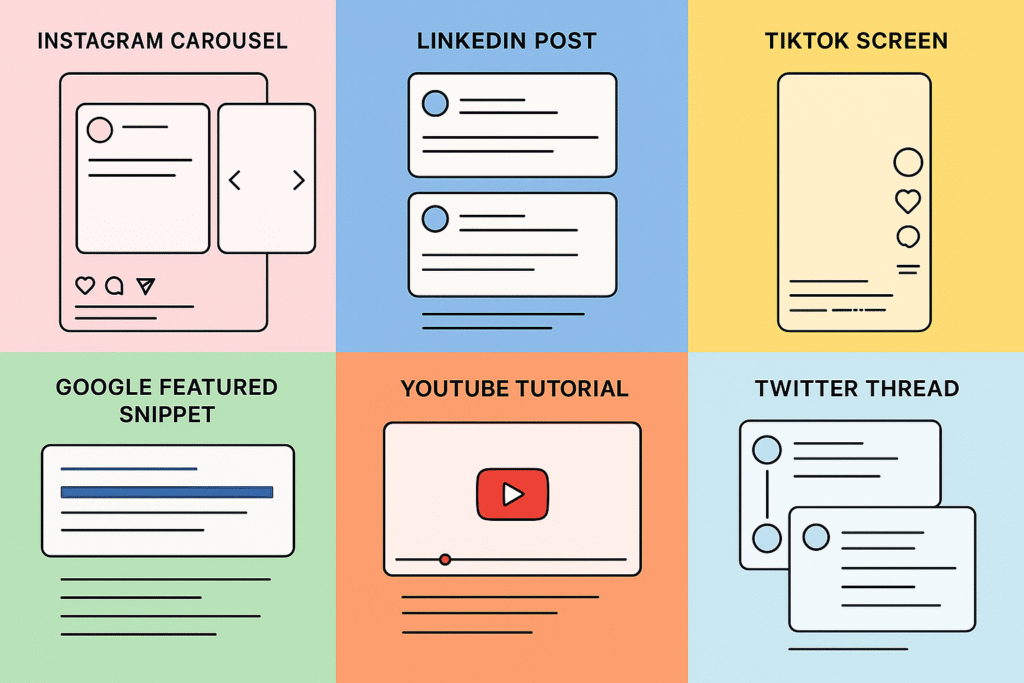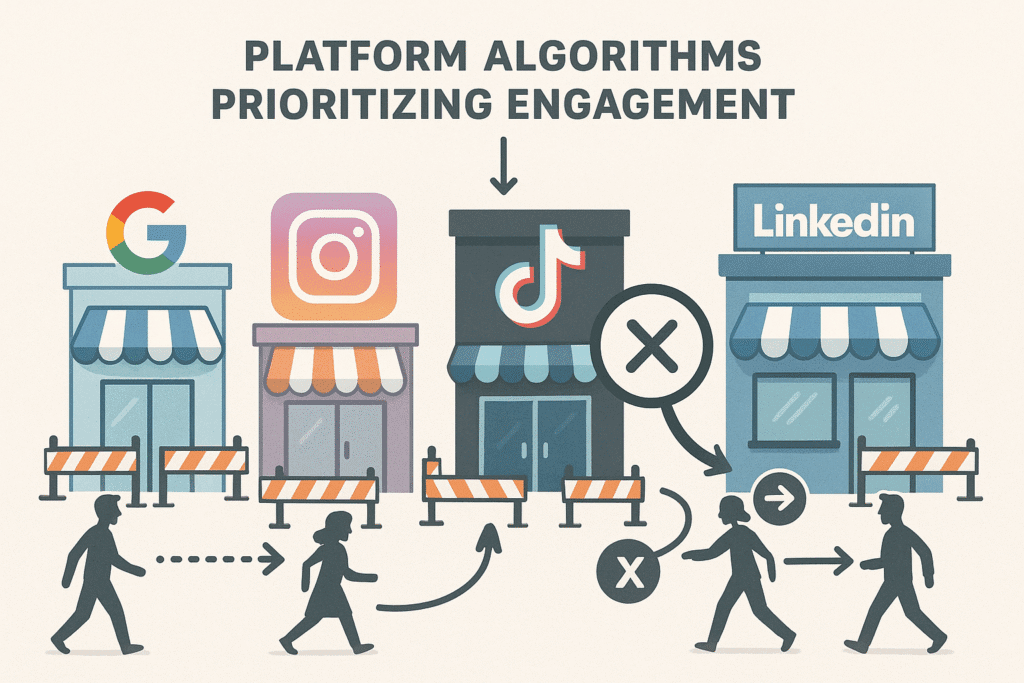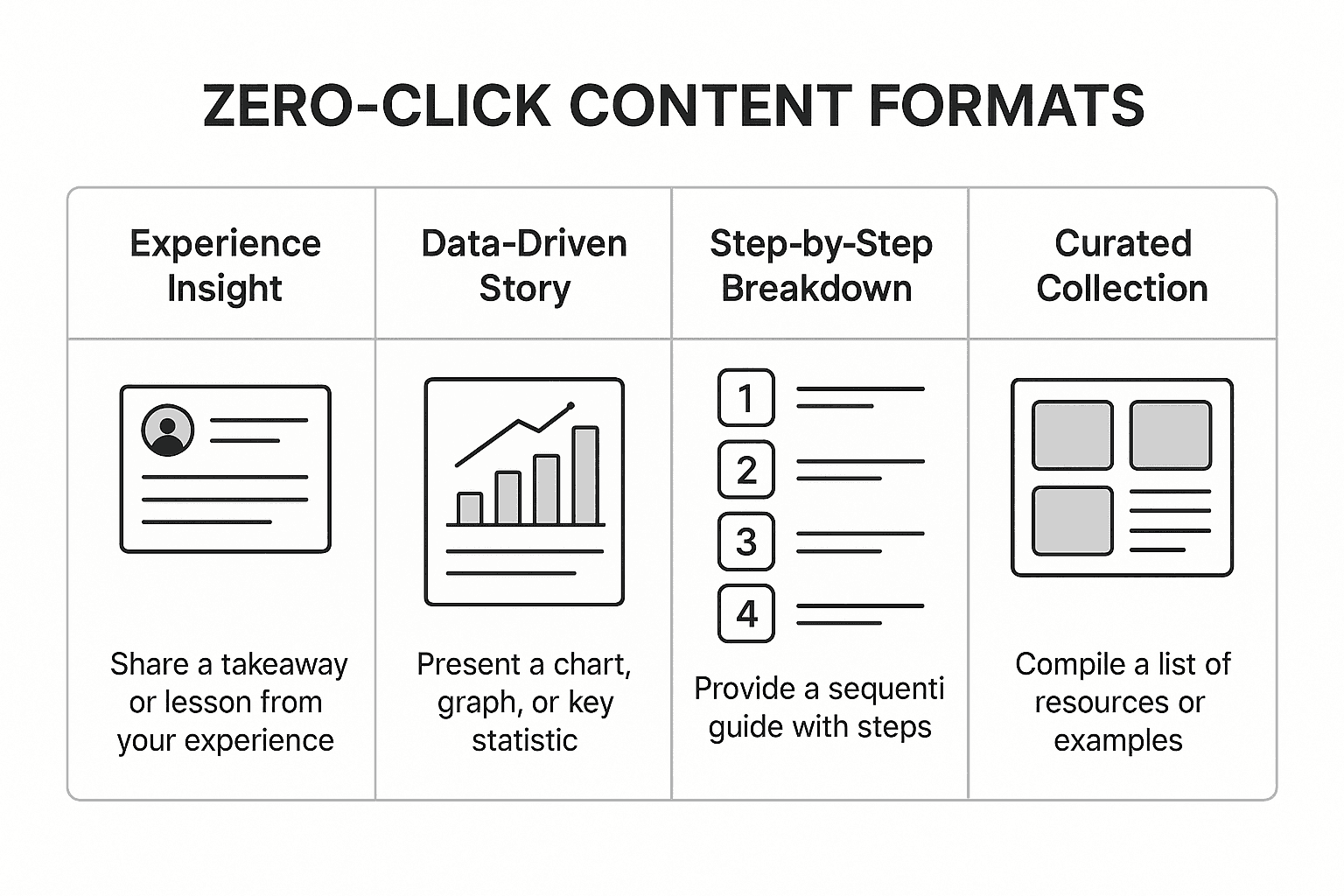The Rise of Zero-Click Content: How to Win Traffic Without a Single Click
Your most successful content might never drive a single visitor to your website—and that’s perfectly fine.
Last week, I was reviewing our analytics when something bizarre caught my attention. Our Instagram post about email marketing tips had 50,000 views and generated zero website clicks. Yet somehow, our email subscribers jumped by 300 that week.
That’s when it hit me: the game has completely changed. Its time to do some changes in the game to stand out of the competition
So What’s This Zero-Click Thing All About?

Remember when we used to obsess over click-through rates? Those days are basically over. Now, your audience consumes your content, learns from it, remembers your brand, and converts later through completely different channels.
Zero-click content means people get everything they need without ever leaving the platform where they found you. They scroll through Instagram, watch your TikTok, read your LinkedIn post, and boom—problem solved. No clicking required.
Here’s what this looks like in practice:
- Instagram carousels teaching productivity systems in 8 slides
- LinkedIn posts sharing negotiation tactics that people screenshot
- TikTok videos solving common problems in under a minute
- Google showing your answer before anyone visits your site
- YouTube tutorials that become the definitive resource
- Twitter threads explaining complex topics through storytelling
The big difference? We used to create teasers hoping people would click for more. Now we deliver complete value upfront. its also benefits us when we post on social media to derive traffic. its important to not give total content on the social media. it can cause us in clicking rates. posting on social media that garbs attention and build curiosity in them to click. it important to remember this.
Why This Shift Happened (And Why It’s Permanent)
Three major forces collided to create this new reality, and honestly, there’s no going back.
Platforms Got Smart About Keeping Users
Instagram loses money every time someone clicks away to your website. Same with LinkedIn, TikTok, Fakebook and yes, even Google. They’ve figured out that happy users scroll more, see more ads, and generate more revenue.
Google now answers almost 20% of searches directly on the results page by its ai overview and Gemini . Instagram basically hides posts with external links from most people’s feeds. LinkedIn’s algorithm rewards posts that spark on-platform conversations.
These platforms have billions of users and unlimited resources. Fighting this trend is like swimming upstream in a hurricane.
Our Brains Adapted to Instant Everything
Nobody wants to wait anymore. We’ve trained ourselves to expect immediate answers, quick solutions, and instant gratification. We not want to spend more energy on extra work like clicking. Why would someone click through to your blog post when they can get the answer in a 30-second video?
I tested this myself. Posted the same tip as a blog post and an Instagram carousel. The carousel got 10x more engagement, even though the blog post had more detailed information.
Mobile Changed How We Consume Information
Over half of all internet usage happens on phones now. Switching between apps is annoying. Loading new websites takes time. Pop-ups are infuriating. Zero-click content eliminates all these friction points.
Plus, people browse social media during micro-moments—waiting in line, riding elevators, sitting in meetings. They want quick value, not deep research sessions.
The Mental Game Behind Non-Clicking Behavior
Understanding why people consume without clicking has been fascinating to study. Three psychological patterns drive this behavior.
Instant rewards feel better than delayed ones. When your content delivers value immediately, it triggers the same satisfaction as completing a task. People feel good, remember your brand, and associate you with positive experiences.
Decision fatigue is real. Every click represents a micro-choice that drains mental energy. Zero-click content removes this friction entirely. People can consume your content passively while doing other things.
Trust builds through consistent generosity. When you consistently provide value without asking for anything, people develop positive associations with your brand. This goodwill converts later, often in ways you can’t track directly.
Last month, someone bought our consulting services after following us for eight months without ever visiting our website. They consumed our LinkedIn content, remembered us when they needed help, and googled our company name directly.
Platform-by-Platform Strategies That Actually Work

Each platform has its own consumption patterns and algorithm preferences. Here’s what I’ve learned from managing accounts across all major channels.
Google: Becoming the Instant Answer
Featured snippets are pure gold for building brand authority without generating clicks. Here’s how to capture them consistently.
Start by identifying questions your audience actually asks. Use AnswerThePublic, scan Reddit discussions, or simply pay attention to customer support tickets. Real questions from real people perform better than keyword research tools.
Structure your answers for easy scanning. Use bullet points, numbered lists, and clear subheadings. Google’s algorithms prefer content they can easily extract and display.
Write complete answers in 40-60 words. Featured snippets typically show this length, so make every word count. Answer the question thoroughly but concisely.
I’ve watched brands build massive awareness through featured snippets alone. People see your content, remember your brand name, and search for you directly later.
Instagram: Visual Education That Sticks
Instagram’s algorithm heavily favors content that keeps people on the platform. Educational carousels consistently outperform single images and even videos in my experience.
Create slide-by-slide tutorials that tell complete stories. Start with a hook, present information logically, and end with a memorable takeaway. People save educational carousels more than any other content type.
Use text overlays strategically. Many people browse Instagram with sound off, especially in professional settings. Your text needs to carry the entire message.
Share behind-the-scenes moments that build authentic connections. Perfect, polished content gets ignored. Real stories about struggles, failures, and lessons learned generate genuine engagement.
LinkedIn: Professional Insights Without the Sales Pitch
LinkedIn rewards authentic professional storytelling more than any other platform. Generic advice gets buried, but personal experiences generate massive engagement.
Share specific lessons from your career journey. Talk about mistakes you made, problems you solved, and insights you gained. Make it educational, not promotional.
Ask questions that spark meaningful discussions. Posts with 50+ thoughtful comments consistently reach more people than posts with hundreds of likes but no conversation.
Break down complex business concepts into digestible insights. Think “MBA lesson in 300 words.” Busy professionals appreciate content that teaches efficiently.
TikTok: Micro-Learning Through Entertainment
TikTok’s algorithm is incredibly sophisticated at matching content with interested audiences. The key is solving specific problems quickly while staying entertaining.
Address single, specific issues in each video. “How to fix this exact problem in 60 seconds” performs better than broad educational content. People share solutions to specific problems.
Leverage trending sounds and formats while adding your expertise. Take popular templates and fill them with valuable information from your industry.
Show transformations and results. Before-and-after content consistently goes viral across all niches. People love seeing progress and improvement.
YouTube: Comprehensive Value in Engaging Formats
YouTube rewards watch time above everything else. Create content that keeps people engaged from start to finish.
Build comprehensive resources that answer every related question. Become the definitive source on specific topics. These videos rank well in both YouTube and Google searches.
Use clear timestamps and sections. Help viewers find exactly what they need quickly. This improves user experience and increases overall watch time.
Address multiple skill levels within single videos. Include beginner tips, intermediate strategies, and advanced techniques. This broadens your potential audience significantly.
Content Formats That Drive Real Results

Through extensive testing across dozens of accounts, these formats consistently generate engagement and brand awareness.
The Experience-Based Insight
Share one specific lesson from your professional experience in 250-400 words. Include what happened, what you learned, and how others can apply it.
Structure: Personal story → Key lesson → Practical application → Thought-provoking question
These posts generate more meaningful engagement than generic tips because they feel authentic and relatable.
The Data-Driven Story
Transform interesting statistics into compelling narratives that inform and entertain your audience.
Start with a surprising number, explain its significance, show real-world implications, and make predictions about future trends.
People remember stories attached to data much better than isolated statistics. This format also positions you as someone who understands industry trends.
The Step-by-Step Breakdown
Deconstruct complex processes into actionable steps that people can implement immediately.
State the goal clearly, list any prerequisites, provide detailed steps with explanations, highlight common pitfalls, and describe expected results.
These posts get saved and shared more than almost any other format because they provide immediate practical value.
The Curated Resource Collection
Aggregate valuable tools, resources, or insights around specific themes, adding your commentary and recommendations.
Introduce the topic and its relevance, share 5-8 carefully selected items with your thoughts, explain why each recommendation matters, and provide your overall assessment.
The key is adding your perspective and experience, not just listing resources. Your curation and commentary provide the value.
Advanced SEO Strategies for Zero-Click Success
Traditional SEO focuses on driving traffic. Zero-click SEO focuses on capturing attention and building authority where people already spend time.
Topic Authority Over Keyword Rankings
Instead of targeting individual keywords, build comprehensive authority around entire subject areas.
Create interconnected content that addresses every aspect of your core expertise. Use natural language variations and related concepts throughout your content. Link ideas together logically and naturally.
Google’s algorithms increasingly understand context and intent. Working with this trend, rather than against it, generates better results.
Voice Search Optimization
People search differently when speaking compared to typing. Optimize for natural, conversational queries.
Use complete sentences and natural phrasing. Answer questions the way you’d respond in conversation. Include location-specific information when relevant.
Voice search results often come from featured snippets, so optimizing for both simultaneously makes strategic sense.
Entity-Based Authority Building
Help search engines understand your expertise through consistent topical associations and reliable information patterns.
Maintain consistent business information across all platforms. Create content around consistent themes that demonstrate deep knowledge. Earn mentions and links from respected sources in your industry.
The goal is becoming the recognized authority on specific subjects, not just ranking for individual keywords.
Measuring Success When Analytics Don’t Tell the Whole Story
Traditional metrics miss the real value of zero-click content. Here’s what actually matters for long-term business growth.
Engagement Quality Indicators
Comments that demonstrate thoughtful consumption matter more than total engagement numbers. People asking follow-up questions or sharing personal experiences show genuine value delivery.
Saves and shares indicate content people want to reference later or recommend to others. Profile visits and follower growth, especially from target demographics, suggest growing brand awareness.
Time spent viewing content, especially on video platforms, shows genuine interest rather than casual scrolling.
Brand Awareness Growth Signals
Direct website traffic often increases when zero-click content strategies work effectively. People discover you through content, remember your brand, then search for you specifically later.
Branded search volume growth indicates people actively looking for your company or personal brand. Email list growth from profile visits suggests people want more direct access to your content.
These metrics are harder to track but more valuable for sustainable business growth.
Authority and Recognition Metrics
Speaking opportunities, podcast invitations, and collaboration requests increase when you’re recognized as an expert in your field.
Media mentions, interview requests, and peer recognition become more common as your authority grows.
These benefits compound over time and often lead to significant business opportunities that traditional analytics can’t measure.
Common Mistakes That Sabotage Zero-Click Strategies
After working with hundreds of content creators and business owners, I’ve identified the patterns that consistently undermine zero-click content effectiveness.
Excessive Self-Promotion
Zero-click content stops working the moment it feels like advertising. People consume content for value, not sales pitches.
The most effective zero-click content barely mentions your business directly. Instead, it demonstrates expertise through helpful information that positions you as a trusted authority.
Platform-Agnostic Approaches
Content that works brilliantly on LinkedIn often fails completely on TikTok. Each platform has unique consumption patterns, algorithm preferences, and audience expectations.
Successful zero-click strategies adapt content style, format, and tone to match platform-specific user behavior rather than using identical approaches everywhere.
Inconsistent Publishing Schedules
Sporadic high-quality content generates less long-term value than consistent solid content. Building audience relationships requires reliable, ongoing value delivery.
Sustainable content creation systems matter more than perfectionist approaches that lead to irregular publishing.
Community Engagement Neglect
Zero-click content often generates questions, discussions, and networking opportunities. Ignoring these interactions wastes valuable relationship-building potential.
Some of the most significant business relationships and opportunities emerge from comment section conversations and direct messages sparked by valuable content.
Building Your Personal Zero-Click Framework
Here’s the systematic approach I use with clients to develop effective zero-click content strategies tailored to their specific situations.
Comprehensive Content Audit
Analyze your existing content performance across all platforms. Identify pieces that generated high engagement without driving website traffic. Look for patterns in topics, formats, and presentation styles that resonated most with your audience.
Use this historical data to inform your strategy rather than relying on generic best practices that may not apply to your specific audience and industry.
Knowledge-Platform Intersection Mapping
Identify where your unique expertise intersects with each platform’s preferred content formats and audience expectations.
Rather than attempting to maintain presence everywhere, focus your efforts on platforms where you can consistently deliver exceptional value in formats that naturally perform well.
Strategic Content Theme Development
Choose 4-6 core subject areas that align with your business objectives and genuinely interest your target audience.
These themes should guide all content creation decisions and help you build recognizable topical authority over time. Consistency in subject matter helps both algorithms and audiences understand your expertise.
Systematic Template Creation
Develop repeatable formats for different types of zero-click content. Templates reduce decision fatigue, speed up content creation, and ensure consistent quality standards.
Create frameworks for educational posts, experience-sharing content, industry commentary, and resource curation that you can adapt for different topics and platforms.
Performance Measurement Systems
Define success metrics that align with your actual business goals rather than vanity metrics like total reach or engagement rates.
Set up tracking systems to monitor brand awareness growth, authority indicators, and long-term conversion patterns that reflect zero-click content’s true business impact.
Future Trends Shaping Zero-Click Content
Several technological and behavioral trends will significantly influence zero-click content strategies over the next few years.
Artificial intelligence will enable hyper-personalized content experiences. Platforms are developing increasingly sophisticated systems for showing people exactly the content they want to see when they want to see it. This makes relevance and genuine value more critical than ever.
Content format boundaries will continue dissolving. The distinctions between text, images, video, and audio are disappearing rapidly. Multi-modal content experiences that combine different media types seamlessly will become standard expectations.
Community-building features will become central to platform algorithms. Social media platforms are prioritizing content that generates meaningful discussions and builds lasting connections between users rather than passive consumption.
Cross-platform content adaptation tools will become essential. Successful content creators will need efficient systems for repurposing and optimizing content across multiple platforms simultaneously while maintaining platform-specific effectiveness.
The Strategic Shift That Changes Everything
The most successful businesses in 2025 won’t be those generating the most website clicks—they’ll be the brands consistently adding value to their audiences’ existing content consumption habits.
This fundamental shift requires completely rethinking traditional content marketing approaches. Instead of interrupting people’s platform experiences to drive them elsewhere, successful zero-click strategies enhance those experiences while building brand relationships.
I’ve watched companies transform their entire marketing approach around this principle. They develop stronger customer relationships, establish greater industry authority, and generate more qualified leads than competitors still focused on traditional traffic-driving strategies.
The audience you want to reach is already consuming content somewhere, making purchasing decisions, and forming brand preferences. The critical question isn’t whether you can get them to visit your website—it’s whether you’re adding meaningful value to their existing content consumption experiences.
Businesses that understand this distinction and execute accordingly will build significant competitive advantages. Start developing your zero-click content strategy now, while your competition is still trying to pull people away from the platforms they love.
